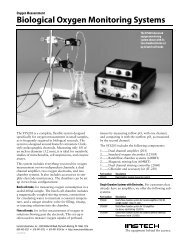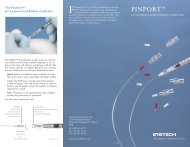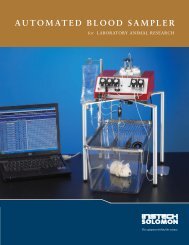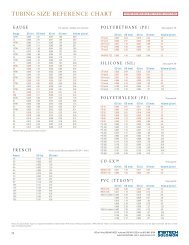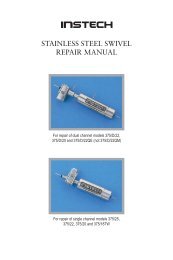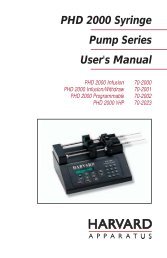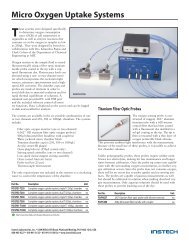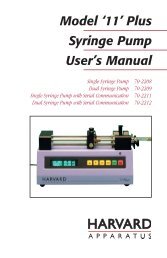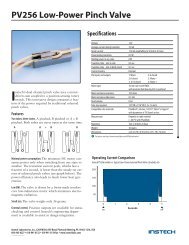110 / 210 Fiber Optic Oxygen Monitor - Instech Laboratories, Inc.
110 / 210 Fiber Optic Oxygen Monitor - Instech Laboratories, Inc.
110 / 210 Fiber Optic Oxygen Monitor - Instech Laboratories, Inc.
Create successful ePaper yourself
Turn your PDF publications into a flip-book with our unique Google optimized e-Paper software.
solution. (However, Henry's Law does not apply to<br />
gases that are extremely soluble in water.) The<br />
concentration (mole %) can be calculated if the<br />
absolute pressure is known:<br />
<strong>Oxygen</strong> mole fraction = oxygen partial pressure /<br />
absolute pressure<br />
Since the FOXY system detects partial pressure of<br />
oxygen, the response in a gas environment is similar<br />
to a liquid environment in equilibrium with gas.<br />
Therefore, it is possible to calibrate the FOXY<br />
system in gas and then use the system with liquid<br />
samples and vice versa if you utilize Henry's Law.<br />
However, Henry's Law does not apply to gases that<br />
are extremely soluble in water. The following<br />
information illustrates the solubility of oxygen in<br />
water at different temperatures.<br />
ln(X) = a + b/T* + cln(T*)<br />
Temperature range: 0° C - 75° C<br />
X is the mole fraction<br />
T* is the T/100 in Kelvin<br />
a -66.7354<br />
b 87.4755<br />
c 24.4526<br />
T (C)<br />
T* (T/100K)<br />
Mole Fraction of oxygen in<br />
water at 1 atmosphere pO2<br />
Weight Fraction (ppm) at<br />
1 atmosphere pO2 (pure O2)<br />
Weight Fraction (ppm) at<br />
0.209476 atmospheres pO2 (Air)<br />
5 2.7815 3.46024E-05 61.46203583 12.87482142<br />
10 2.8315 3.06991E-05 54.52891411 11.42249881<br />
15 2.8815 2.75552E-05 48.94460474 10.25272002<br />
20 2.9315 2.50049E-05 44.41468119 9.303809756<br />
25 2.9815 2.29245E-05 40.71933198 8.529722785<br />
30 3.0315 2.12205E-05 37.69265242 7.895706058<br />
35 3.0815 1.98218E-05 35.20817214 7.375267068<br />
40 3.1315 1.86735E-05 33.16861329 6.948028438<br />
Temperature<br />
Temperature affects the fluorescence decay time, the<br />
fluorescence intensity and the collisional frequency<br />
of the oxygen molecules with the fluorophore -- and<br />
therefore, the diffusion coefficient of oxygen.<br />
Temperature also affects the solubility of oxygen in<br />
samples. The net effect of temperature fluctuations is<br />
seen as a change in the calibration slope. It is best to<br />
maintain the sample at a constant (+/-1° C)<br />
temperature. If this is not practical, then you should<br />
calibrate your FOXY system by using the<br />
temperature compensation features and measuring<br />
temperature and oxygen concurrently. To monitor the<br />
temperature of the sensing environment and<br />
compensate for temperature fluctuations, temperature<br />
electrodes can now be used in conjunction with the<br />
FOXY probe. (Optional thermistor and K-type<br />
thermocouple accessories are available.) OOISensors<br />
Software corrects for changes in data due to<br />
temperature fluctuations. At the present time,<br />
automatic compensation only works for gaseous<br />
measurements. (Check with <strong>Instech</strong> <strong>Laboratories</strong> for<br />
possible work-around when making dissolved oxygen<br />
measurements).<br />
Scattering Media with uncoated probe<br />
Fluorescence emissions from the ruthenium complex<br />
propagate in all directions. In clear media, only those<br />
emissions propagating toward the fiber within the<br />
acceptance angle of the probe are detected. If the<br />
probe tip is held near a reflecting surface, or<br />
immersed in a highly scattering media, the<br />
fluorescence signal will increase. The increase will<br />
be proportional for both the intensity of the<br />
fluorescence at a pressure of oxygen and the intensity<br />
of fluorescence at zero pressure of oxygen, but will<br />
not affect the Stern-Volmer constant. For this reason,<br />
it is necessary to measure the intensity of<br />
fluorescence at zero pressure of oxygen in the<br />
sample. Also, if you are measuring oxygen in highly<br />
scattering media, then the standards you use for your<br />
calibration procedure should be in the same media as<br />
your sample for the most accurate results.<br />
Samples to Use<br />
♦ If you are using the probe in gases, N 2 can be<br />
used for the low value (0%) and either air<br />
(20.9%) or O 2 (100%) can be used for the high<br />
value.<br />
♦ If you are using the probe in liquid media, it may<br />
be difficult to prepare standards. Sodium<br />
29






